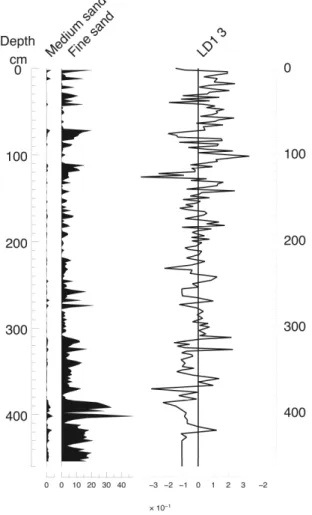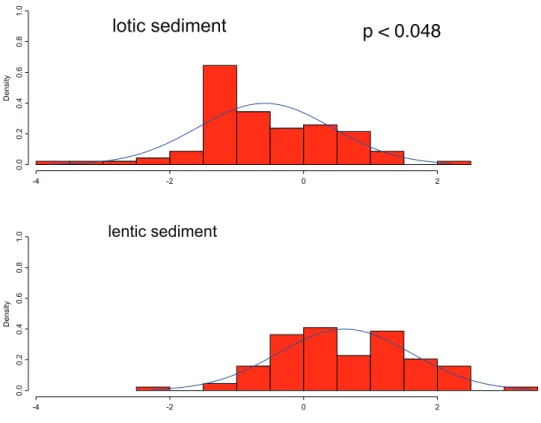Reconstruction of Flood Events in Oxbow Sediment by Subfossil
Cladocerans
János KORPONAI1,2, László FORRÓ3, Mihály BRAUN4, Csilla KÖVÉR1, István PAPP5, István
GYULAI6
1Department of Chemistry and Environmental Sciences, University of West Hungary, Szombathely, Hungary 2West-Transdanubian District Water Authority, Csik F. u. 4., H-8360 Keszthely, Hungary e-mail:
korponai.janos@nyuduvizig.hu
3Department of Zoology, Hungarian Natural History Museum, 1088 Budapest, Hungary
4Department of Inorganic and Analytical Chemistry, University of Debrecen, Debrecen, Hungary 5Department of Mineralogy and Geology, University of Debrecen, Debrecen, Hungary
6Department of Ecology, University of Debrecen, Debrecen, Hungary
Introduction
Lake sediment sequences provide evidence on the history of a lake and its surroundings. Abundance of Cladocera depends, among others, on either food supply or predation. Analyses of Cladocera remains and other biological proxies are extremely useful tools for the evaluation of a lake’s response to environmental changes such as eutrophication, acidification, trophic structure and climate change (see in Jeppesen et al., 2011).
Materials and methods
Study area
Marótzugi-Holt-Tisza is a small oxbow lake (length 1.8 km; width 60 m; area 10 ha) near the village Gávavencsellő in NE Hungary (48° 10’28’’N, 21° 37’09’’E). Owing to the richness of the biota it has been registered as a nature reserve and wildlife sanctuary, and selected as part of the pilot project area for the PHARE-sponsored Hungarian National Biodiversity Monitoring Programme (Müller et al. 2000). The basin of the oxbow was created in 1860 when a large bend of river Tisza was cut through in the frame of the water regulation. We chose this oxbow lake due to its known formation date and due to its location on the floodplain. These characteristics allow this oxbow lake to be used as a model area for studying sediment accumulation processes.
Sampling
Overlapping sediment cores were taken by using a rod-operated piston sampler which provides 460 cm long undisturbed core samples even from shallow water.
Subsamples (1 cm3) were taken at 2 cm intervals in order to determine Cladocera remains and grain size distribution. Subsamples for the Cladocera analysis were treated with 10% KOH, 10% HCl, and concentrated HF solutions; they were consequently sieved through a 35 µm mesh (Frey, 1986).
To determine the density of Cladocera species, only well preserved chitinous remains were taken into consideration (headshields, carapaces, postabdomens, post-abdominal claws, and ephippia; fragments were counted only if unambiguous diagnostic marks were found). The most frequent body parts of each taxon were used for estimation of their abundance per unit volume (density: ind cm-3). The composition of the Cladocera community was estimated on the basis of determination of at least 300 individuals in each subsample (Korhola & Rautio, 2001). Identification was carried out according to Frey (1950, 1962, 1988, 1991),
Goulden & Frey (1963), Gulyás & Forró (1999), Sebestyén (1965, 1969, 1970, 1971), Szeroczyńska & Sarmaja-Korjonen (2007), and Whiteside et al. (1978).
For grain size distribution, subsamples were dried at 105 C in thermostat for at least 24 h before recording dry masses. Dried and poured samples were mixed with 0,5 cm3 0,002 M sodium-oxalate then 2 cm3 concentrate glycerine were added.
The samples were analysed for particle size characterization using a Malvern Mastersizer 2000. This system measures volumetric grain sizes between 0.1-2000 microns by analyzing in-situ the angle of refraction of a laser beam that is aimed through the container holding the sediment/dilutents.
Statistical evaluation
Statistical analyses were carried out on the Cladocera relative abundance data. The classification of trophic levels was tested by discriminant analysis (DA) using arc-sine square root transformed relative abundance of Cladocera species.
Multivariate statistical analyses were made by using the software PSIMPOLL (Bennett, 2005), R-software (R Development Core Team, 2010), and rioja (Juggins, 2009) packages. Results and discussion
There were remains of 34 Cladocera species along the core of the oxbow. These species are very common in littoral habitats of eutrophic shallow lakes with dense macrophytes.
Only ten species achieved dominant status (10% in at least one subsample), of which nine were hydorids, and only three long-term dominants were found throughout the profile: Alona
rectangula, Acroperus harpae, and Chydorus sphaericus. The planktonic species was
Bosmian longirostris. Four zones were distinguished on the basis of abundance of Cladocera
the shoreline of this meander. Proportion of Bosmina longispina increased in the next Clad-2
and Clad-3 zones. This species is common, occuring in all type of water bodies in Hungary,
but the abundance has never been so high. Their increased proportion of this species in Clad-2 and Clad-3 zones proved that the water regime was changed to lentic system. Lentic environment was frequently interrupted by heavy flush.
Figure 2. Medium and fine sand fraction in grain size distribution, and discriminant scores in the sediment core of Marótzugi-Holt-Tisza oxbow.
Flood events were defined as fine sand (50 µm grain size) portion exceed 3%. When fine sand portion was less than 3% we defined the state of the oxbow as lentic, otherwise it was lotic. Results of discriminant analysis (LD1 3) on the cladoceran data confirmed lotic/lentic water regime changing (fig. 2). Group centroids of the cladoceran assemblages of the different water regime states were separated well (Wilk’s lambda: 0.7249, P<0.05; fig. 3) and LD1 3 scores show correlation with fine sand portion (r= -0.4261, t = -6.3027, df = 179, P<0.05).
lotic sediment D e n si ty -4 -2 0 2 0 .0 0 .2 0 .4 0 .6 0 .8 1 .0 lentic sediment D e n si ty -4 -2 0 2 0 .0 0 .2 0 .4 0 .6 0 .8 1 .0 p < 0.048
Fig. 3. Distribution of discriminant scores of cladoceran species according to lentic/lotic states
Acknowledgements : This study was financially supported by Hungarian National Science Foundation, OTKA-T 049098 and Hungarian National Research and Development Program BALÖKO 3B022/04, TÁMOP 4.2.2-08/1-2008-0020, TÁMOP 4.2.1/B-09/1/KONV-2010-0006.
References
Bennett, K. D., 2005. Documentation for psimpoll 4.25 and psimcomb 1.3. C program for plotting pollen diagram and analysing pollen data.
Frey, D. G., 1950. The taxonomic and phylogenetic significance of the head pores of the Chydoridae (Cladocera). Internationale Revue gesamten Hydrobiologie 44: 27-50. Frey, D. G., 1962. Cladocera from the Eemian interglacial of Denmark. Journal of
Paleontology 36: 1133-1154.
Frey, D. G., 1986. Cladocera analysis. In: B. E. Berglund (ed.), Handbook of palaeooecology and palaeohydrology. John Wiley & Sons, Chichester, U.S.A.: 692-667.
Frey, D. G., 1988. Littoral and offshore communities of diatoms, cladocerans and dipterous larvae, and their interpretation in paleolimnology. Journal of Paleolimnology 1: 179-191.
Gulyás, P. & L. Forró, 1999. Az ágascsápú rákok (Cladocera) kishatározója. Vízi Természet- és Könyezetvédelem 9. KGI, Budapest, 2nd edition. [A guide for the identification of Cladocera occurring in Hungary. In Hungarian.]
Jeppesen, E., Nõges, P., Davidson, T. a., Haberman, J., Nõges, T., Blank, K., Lauridsen, T. L., et al. (2011). Zooplankton as indicators in lakes: a scientific-based plea for including zooplankton in the ecological quality assessment of lakes according to the European Water Framework Directive (WFD). Hydrobiologia, 676(1), 279-297.
doi:10.1007/s10750-011-0831-0
Juggins, S., 2009. rioja: Analysis of Quaternary Science Data, R package version 0.5-6. http://cran.r-project.org/package=rioja.
Korhola, A., & M. Rautio, 2001. 2. Cladocera and other Branchiopod crustaceans. In J. P. Smol, H. J. B. Birks, & W. M. Last (Eds.), Tracking Environmental Change Using Lake
Sediments. Volume 4: Zoological Indicators (pp. 1-38). Kluwer Academic Publishers,
Dordrecht, The Netherlands.
Müller Zoltán, Dévai Gy, Miskolczi M, Kiss B, Tóth A, Nagy S., Grigorszky I. és Jakab T., 2000. A szitakötők, mint az élőhelyi heterogenitás indikátorainak vizsgálata a Tisza-hullámtér Tiszabercel és Gávavencsellő közötti szakaszán. Hidrológiai közlöny, 5-6: 373-376.
R Development Core Team, 2010. R: A Language and Environment for Statistical Computing. R Foundation for Statistical Computing, Vienna, Austria. ISBN 3-900051-07-0. URL http://www.R-project.org.
Sebestyén, O., 1934. Appearance and rapid increase of Dreissena polymorpha Pall. and Corophium curvispinum G. O. Sars forma devium Wundsch in Lake Balaton. Archiva Biologica Hungarica 7: 190-204.
Sebestyén, O., 1965. Kladocera tanulmányok a Balatonon III. Tótörténeti előtanulmányok I – Cladocera studies in Lake Balaton III. Preliminary studies for lake history investigations. Annales Instituti Biologici (Tihany) Hungaricae Academie Scientarium 36: 229-256. Sebestyén, O., 1969. Kladocera tanulmányok a Balatonon IV. Negyedkori maradványok a
Balaton üledékében I – Cladocera studies in Lake Balaton IV. Quaternary remains in the sediment of Lake Balaton I. Annales Instituti Biologici (Tihany) Hungaricae Academie Scientarium 36: 229-256.
Sebestyén, O., 1970. Kladocera tanulmányok a Balatonon IV. Negyedkori maradványok a Balaton üledékében II – Cladocera studies in Lake Balaton IV. Quaternary remains in the sediment of Lake Balaton II. Annales Instituti Biologici (Tihany) Hungaricae Academie Scientarium 37: 247-279.
Sebestyén, O., 1971. Kladocera tanulmányok a Balatonon IV. Negyedkori maradványok a Balaton üledékében III – Cladocera studies in Lake Balaton IV. Quaternary remains in the sediment of Lake Balaton III. Annales Instituti Biologici (Tihany) Hungaricae Academie Scientarium 38: 227-268.
Szeroczyńska, K. & K. Sarmaja-Korjonen, 2007. Atlas of subfossil Cladocera from central and northern Europe. Friends of the Lower Vistula Society, Świecie, Poland.
Whiteside, M. C., J. B. Williams & C. P. White, 1978. Seasonal abundance and pattern of Chydorid, Cladocera in mud and vegetative habitats. Ecology 59: 1177-1188.

